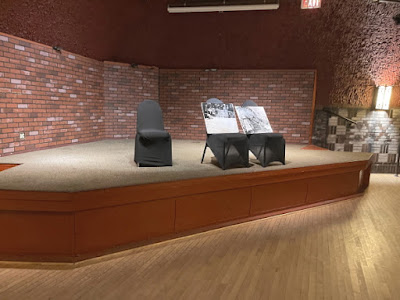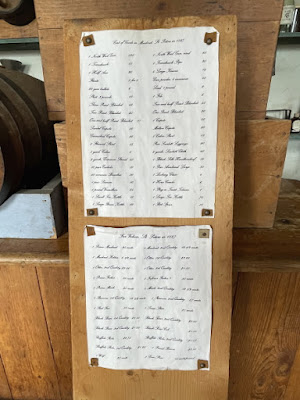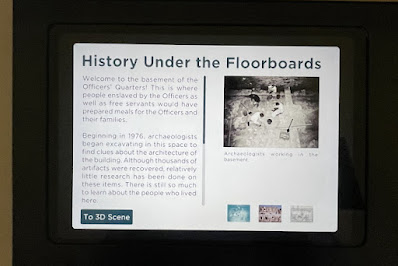 |
| Photographer Unknown |
Lieutenant Zebulon Pike realized the importance of establishing a fort near the confluence of the St. Croix and Mississippi Rivers, so in 1805 he signed the Treaty of St. Peters with the Dakota Indians for a site. The treaty later became known as Pike's Purchase, which included 155,320 acres of land for an undisclosed amount of money. Because Pike failed to include a payment amount, Congress randomly approved a payment of $2,000.
The only problem with the transaction was that Pike did not have any authority to sign a treaty or purchase any land from the Indians; so it has long been debated if the purchase was even valid. In any event, a fort was built on a bluff overlooking the Mississippi River in what is now Saint Paul, Minnesota.
Visitors can only visit the fort on a guided tour. I typically dislike guided tours, but this tour was not as bad as some I have taken. I actually learned several things that I probably would have missed on a self-guided tour. One of the things that really surprised me was when the guide told us that there were no trees in this part of Minnesota when the fort was established. Apparently, in the 1800s this area was part of the Great Plains that contained natural grasses. The soldiers and early settlers started planting trees when they arrived, and now there are no grasslands remaining.
Tours of the fort start at the visitor center and last for 1-to-1.5 hours. While waiting for the tour to start, people can view a number of historic exhibits in the visitor center museum.
Before the Civil War, Army officers were allowed to bring their personal enslaved people to the Fort. One enslaved couple was Dred and Harriet Scott, who lived at the fort in the 1830s and 1840s. Because the Scotts lived at the fort for so long, in 1846 they sued for their freedom arguing that having lived in a "free territory," made them "free." In 1857, the case went to the US Supreme Court and became known as Dred Scott v. Sanford. In a landmark decision, the Court held that the Constitution did not apply to people of African descent. This was one of the reasons for the Civil War four years later.







Our tour group entered the fort through a gate on the north side of the property that led to the Parade Grounds. First stop was at the Sutler Store, which was like a post exchange or PX. Sutlers were civilians that contracted with the military to sell goods that the military did not supply. The stores also served as soldiers' clubs and mail rooms. Because paper money and small coins were not used, silver dollars were cut in half for 50-cents, fourths for 25-cents and eights for 12.5-cents. The cut pieces were referred to as "bits," so 8-bits was a dollar, 4-bits was 50-cents, 2-bits was 25-cents, and 1-bit was 12.5 cents. A tray of "bits" was on display in the store.


The enlisted men's barracks were small and crowded. There were 12 men per room, with three small bunk beds in each room (2 men per bed).
The commanding officer had the only single-family house on the post, which was also used for entertaining visiting dignitaries and parties for lower ranking officers. During this time period, officers could be demoted if they were caught associating with an enlisted person.
The officers' quarters were adjacent to the post commander's house, and considerably nicer than the enlisted men's barracks. Families had their own rooms, while single officers shared quarters with other single officers.

Officers Row is currently in disarray because archeologists have removed the floors in many rooms to study earlier construction on the same site. A sign explained that approximately 28,000 objects have been found under the floor boards, but very little research has been completed on the items.
Fort Snelling had to be self-sufficient because it was an isolated post. A placard stated: "...supplies were as much as a month away, and could only be shipped in summer...Bakers made 450 loves of bread every day. The blacksmith shod work animals and repaired metal. Carpenters and wheelwrights repaired wooden items. A armor shop maintained weapons, and a harness shop made and maintained leather goods."
What looked like a water well located in a small building was actually a lift. To store items in a cool environment, a series of underground storage rooms were made 8-stories deep. A winch was used to bring items up from the lower levels.
The post doctor's office was located on the ground level of a two-story building
There was a small 12-pound cannon locate on the top floor of the south battery, but the cannon's shot length was limited to the length of the fort wall.
Although we entered the fort on the north side of the property, the fort's main gate was on the west wall. The gatehouse and guardhouse were located at the main gate and controlled all access to the fort. The buildings also functioned as a police station and a fire department.
The Round Tower had musket slits facing both inside and outside of the fort. In case of an attack, the tower was considered to be the last line of defense, or "last ditch" in military language. There was a 12-pound cannon located on the roof.
The Wabasha Street Caves are actually old abandoned silica mines that date back to the 1840s. In the 1920s, the mines were developed as a restaurant, nightclub speakeasy, and casino. Although no records exist concerning the patrons, legend has it that John Dillinger, Ma Barker, Baby Face Nelson, and other gangsters frequented the establishment. The business continued under the name Castle Royal, until the start of World War II.
After the war, Castle Royal did not reopen as a retail establishment; so the caves were used to grow mushrooms. Then, in 1970, Castle Royal 2 was opened as a disco dance hall. After the disco era, the club once again closed until the the 1990s, when it was reopened as a swing dance establishment. The club now features the big band music of Tommy Dorsey, Glen Miller, Duke Ellington, and others. They also claim to have the longest bar in Minnesota.












During the day, guided tours are given around the Castle Royal space and the back parts of the mines that were used for growing mushrooms. The guides also provide tales of mobsters and murders that allegedly happened one night. However, when police came to investigate the crime, there were no witnesses, no dead bodies, no blood stains, and no one that knew anything about any murders. No one was ever charged with anything, To justify that there really was a killing, our guide showed us bullet holes in various places. Also, when the lights were turned off, we were told that if we looked closely we could see ghost of the people that were killed.
Rice Park was the first public space in downtown St. Paul when it was donated to the City in 1849. Surrounding the park are a number of historic buildings, including the historic Landmark Center. Located within the park is a large water fountain, flower gardens, event/gathering space, benches, and public art installations.
Charles M. Schulz was born in Minneapolis on November 26, 1922, and grew up in Saint Paul. He was an only child and nicknamed "Sparky," after a horse named "Spark Plug" in a comic strip which he enjoyed reading. He had a dog named "Spike" who ate pins and tacks, so in 1937 he drew a picture of Spike and sent it to Ripley's Believe It or Not. His drawing appeared in Robert Ripley's syndicated panel, captioned, "A hunting dog that eats pins, tacks, and razor blades is owned by C.F. Schultz, and drawn by 'Sparky.'"
In 1952, his comic strip Peanuts first appeared in seven newspapers, but soon became one of the most popular comic strips of all time. At its height, Peanuts was published in over 2,600 papers, in 75 countries, and in 21 languages. Over 50 years, Schulz drew 17,897 Peanuts strips.
Located in Rice Park and the surrounding area are a number of bronze statues of Peanuts characters.
The Minnesota State Capitol Building was constructed in 1905 and the design was influenced by the 1893 World's Columbian Exposition in Chicago. From 2013 to 2017, the building underwent extensive renovations. I did not stay long because it was cold and raining and felt like it might start snowing, so I decided it was time to end my Minnesota RonnieAdventure and return to Las Vegas. When I arrived at the airport, Snoopy waved goodbye and said to come back to Minnesota sometime for another adventure.





















































































No comments:
Post a Comment